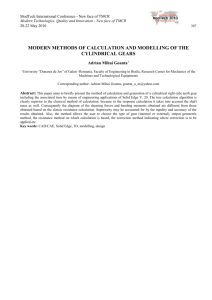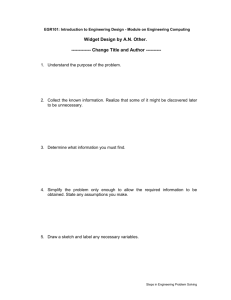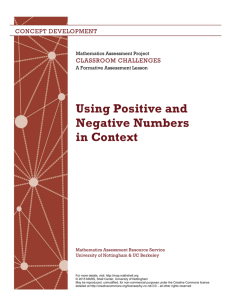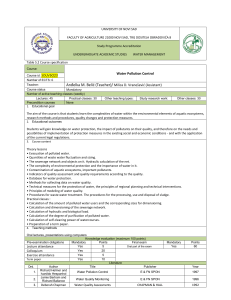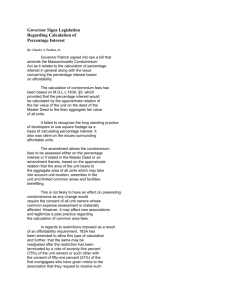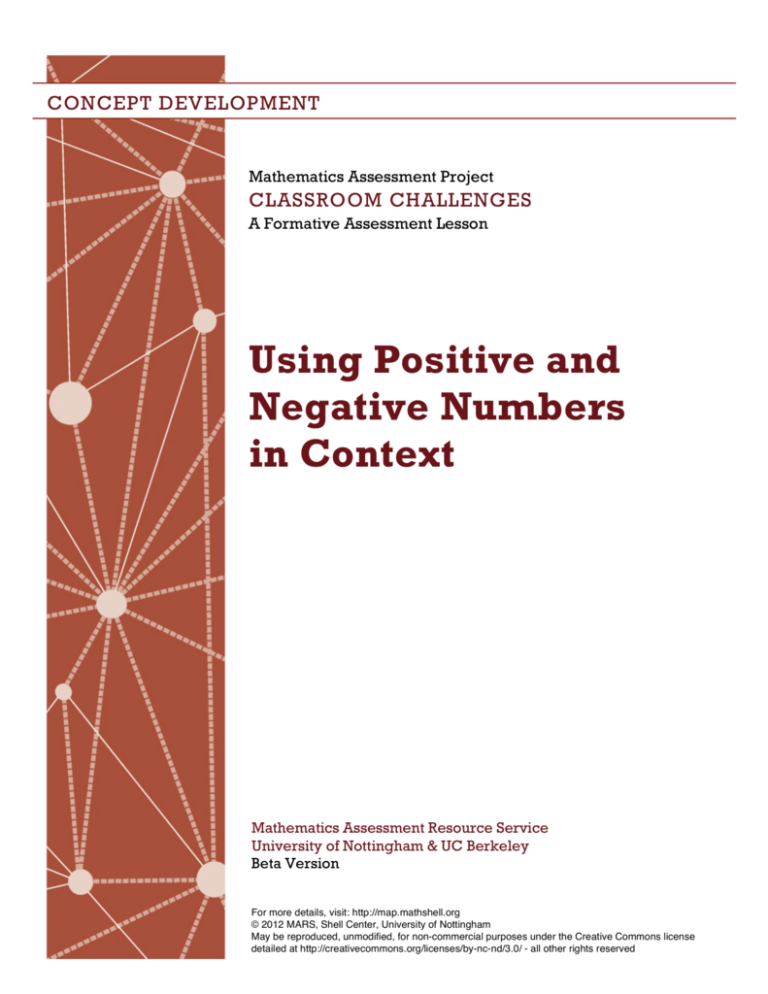
CONCEPT DEVELOPMENT
Mathematics Assessment Project
CLASSROOM CHALLENGES
A Formative Assessment Lesson
Using Positive and
Negative Numbers
in Context
Mathematics Assessment Resource Service
University of Nottingham & UC Berkeley
Beta Version
For more details, visit: http://map.mathshell.org
© 2012 MARS, Shell Center, University of Nottingham
May be reproduced, unmodified, for non-commercial purposes under the Creative Commons license
detailed at http://creativecommons.org/licenses/by-nc-nd/3.0/ - all other rights reserved
Using Positive and Negative Numbers in Context
MATHEMATICAL GOALS
This lesson unit is intended to help you assess how well students are able to understand and use
directed numbers in context. It is intended to help identify and aid students who have difficulties in
ordering, comparing, adding, and subtracting positive and negative integers. Particular attention is
paid to the use of negative numbers on number lines to explore the structures:
starting temperature + change in temperature = final temperature
final temperature – change in temperature = starting temperature
final temperature – starting temperature = change in temperature
COMMON CORE STATE STANDARDS
This lesson relates to the following Standards for Mathematical Content in the Common Core State
Standards for Mathematics:
7.NS
Apply and extend previous understandings of operations with fractions to add, subtract,
multiply, and divide rational numbers.
7.EE Solve real-life and mathematical problems using numerical and algebraic expressions and
equations.
This lesson also relates to the following Standards for Mathematical Practice in the Common Core
State Standards for Mathematics:
1.
2.
4.
7.
Make sense of problems and persevere in solving them.
Reason abstractly and quantitatively.
Model with mathematics.
Look for and make use of structure.
INTRODUCTION
The lesson unit is structured in the following way:
• Before the lesson students should work individually on an assessment task designed to help you
understand their current levels of understanding and difficulties. You review their responses and
write questions to help them improve their work.
• After a whole-class introduction, students work together in small groups on a card-matching task.
In the same small groups, they then create directed number calculations to correspond to
temperature changes or city temperatures. To end the lesson there is a whole-class discussion.
• In a follow-up session, students again work alone on task similar to the assessment task.
MATERIALS REQUIRED
•
•
•
•
Each student will need a copy of the assessment task, Temperature Changes and the review task,
Temperature Changes (revisited), a copy of the Temperature Scale, a mini-whiteboard, a pen, and
an eraser.
Each small group of students will need a set of cut-up cards from the sheets City Temperatures
and Changes in Temperature, a glue stick, and a chart-sized sheet of paper for making a poster.
You will also need one copy of the cut-up cards Introduction to Negative Numbers.
There are some projectable resources to help with discussions.
TIME NEEDED
15 minutes before the lesson, a 60-minute lesson, and 20 minutes in a follow-up lesson (or for
homework). Timings are approximate and will depend on the needs of your class.
Teacher guide
Using Positive and Negative Numbers in Context
T-1
BEFORE THE LESSON
Assessment task: Temperature Changes (15 minutes)
Have students complete this task in class or for
Temperature Changes
homework a few days before the formative assessment
1.
The temperature was +3°C at midday.
lesson. This will give you an opportunity to assess the
By evening, the temperature was !5°C.
work, and to find out the kinds of difficulties students
(a) Some of the calculations below show how to figure out the temperature
change.
have with it You should then be able to target your help
Circle any that apply.
more effectively in the follow-up lesson.
3!5
3 + (!5)
(!5) ! 3
(!5) + 3
Positive and Negative Numbers
Give each student a copy of the task Temperature
Changes.
Spend 15 minutes on your own, answering these
questions.
Explain all your answers carefully.
It is important that, as far as possible, students are allowed
to answer the questions without your assistance.
Student Materials
Alpha Version January 2012
(b) What was the change in temperature? Explain your answer.
2.
The temperature was !7°C at midnight.
By the next day, the temperature had risen by 11°C.
(a) Some of these calculations show how to figure out the temperature the next day.
Circle any that apply.
7 ! 11
11 + (!7)
(!11) ! (!7)
(!7) + 11
(b) What was the temperature the next day? Explain your answer.
Students should not worry too much if they cannot
understand or do everything, because in the next lesson
they will engage in a similar task that should help them to progress.
© 2012 MARS University of Nottingham
S-1
Assessing students’ responses
Collect students’ responses to the task, and note what
their work reveals about their current levels of
understanding and their different approaches.
We suggest that you do not score students’ work. The
research shows that this will be counterproductive, as it
will encourage students to compare their scores, and
will distract their attention from what they can do to
improve their mathematics. Instead, help students to
make further progress by summarizing their difficulties
as a series of questions. Some suggestions for these are
given on the next page. These have been drawn from
common difficulties observed in trials of this unit.
Positive and Negative Numbers
Student Materials
Alpha Version January 2012
3. Here is a calculation:
5 ! (!11)
(a) Figure out the answer to the calculation:
(b) Which of these story questions fits the calculation? Circle any that apply.
A
It was really cold at midnight.
During the morning, the temperature rose 5°C.
By midday, it had reached -11°C.
What was the temperature at midnight?
B
The temperature at midnight was !11°C.
By midday, the temperature was 5°C.
What was the temperature change?
C
At midday, the temperature was 5°C.
The temperature then fell by 11°C.
What was the final temperature?
Explain your answer:
We suggest you write or select questions that apply to your students’ work. You may choose to write
questions on each student’s work. If you do not have time to do this, select a few questions that will
be of help to the majority of students. These can be written on the board at the start of the follow-up
lesson.
© 2012 MARS University of Nottingham
S-2
Teacher guide
Using Positive and Negative Numbers in Context
T-2
Common issues:
Suggested questions and prompts:
Student chooses an expression that does not
represent the story (Q1, 2)
For example: The student chooses the 1st, 2nd
or 4th expressions to represent the temperature
change (Q1).
Or: The student chooses the 1st or 3rd
expressions to represent the next-day
temperature (Q2).
Student makes a calculation error
For example: The student writes
‘−5 − 3 = − 2’
Or: The student writes ‘(−5) + (−11) = (−6)’
Student chooses a story that is not
represented by the expression (Q3)
For example: The student connects the
expression 5 - (-11) with Story A or Story C.
Student provides little or no explanation
For example: The student writes down correct
numerical solutions but does not provide any
explanation of how he/she generated them.
Or: The student writes correct procedures but
does not explain the links between context and
operations.
Student answers all questions correctly
Teacher guide
• Write what you are asked to figure out in words.
How can you write this calculation in math?
• Mark the start and finish temperatures on your
Temperature Scale. Does the temperature rise or
fall? What is the difference between the two
temperatures? Is the temperature change positive
or negative?
• What does the negative sign represent in −7?
What does the middle negative sign represent in
(−11) − (−7)?
• Mark the beginning and end temperatures on
your Temperature Scale. From the first figure,
which direction do you move in? Does your
solution make sense?
• How does the calculation represent what happens
to the temperature in the story? How can you
write that in words?
• (Story A) What is the temperature at midday?
Mark this on your Temperature Scale. By how
much does the temperature change to reach that
temperature? Write this story as a calculation.
• (Story C) What was the temperature at midday?
Mark this on your temperature scale. By how
much does the temperature change? How would
you write this story as a calculation?
• Imagine students in a lower Grade are going to
read your solution. How can you explain very
clearly, so that they understand?
• How do you know that this calculation matches
that story? Explain your answer clearly.
• Make up a calculation using positive and
negative numbers. Now write a story to fit that
calculation. Explain how the calculation and
story fit together.
Using Positive and Negative Numbers in Context
T-3
SUGGESTED LESSON OUTLINE
Whole-class interactive introduction (10 minutes)
Give each student a mini-whiteboard, a pen, and an eraser.
Explain to the class that in the lesson they will be working with positive and negative numbers in the
context of temperatures, in degrees Celsius.
In degrees Celsius, at what temperature does water boil? [100°C.]
In degrees Celsius, at what temperature does water freeze? [0°C.]
In degrees Celsius, what is an average temperature for a summer’s/winter’s day?
Give each student one copy of the sheet Temperature Scales.
Ask four students to come to the front of the room and give each of them a card from the sheet Card
Set: Introduction to Negative Numbers.
Ask the four students to stand in order of temperature from coldest to hottest.
Who thinks they are in the correct order? Who thinks they are not in the correct order?
If students disagree with the order, ask one or two to explain their thinking. Many students find it
difficult to come to terms with the notion that –11°C is colder than –8° C.
Ask the students to return to their seats.
Now project Slide P-1 of the projector resource onto the board (or draw the diagrams on the board).
Temperature Changes
London
+13°C
Beijing
!5°C
Paris
+22°C
Vancouver
!11°C
Projector Resources
Using Positive and Negative Numbers in Context
P-1
Ask students to write on their mini-whiteboards the answers to questions such as the following. Each
time, ask students to explain their method.
If I fly from London to Beijing, does the temperature rise or fall?
What is the change in temperature? [–18°C.] How do you know?
If I fly from Vancouver to Paris, does the temperature rise or fall?
What is the change in temperature? [+33°C.]
The temperature change is +24°C. What was my journey? [Vancouver to London.]
The temperature change is –6°C. What was my journey? [Beijing to Vancouver.]
Cairo is 30°C warmer than Beijing. What is the temperature in Cairo? [+25°C.]
Write the temperature changes between the relevant cities on the board. Draw in new arrows as
necessary. The figures should go in the arrows.
Teacher guide
Using Positive and Negative Numbers in Context
T-4
Collaborative work 1 (10 minutes)
Organize the class into groups of two or three students.
Give each group a large sheet of paper for making a poster, the Card Set: City Temperatures, and
Card Set: Changes in Temperature.
What do you think the two sets of cards represent?
Explain to students how they should work together:
Take turns to place cards.
When it is your turn, connect two City Temperature cards using an arrow from the Changes in
Temperature cards. Figure out any missing temperatures.
Write the calculations, and give reasons explaining your calculations.
If others in your group disagree, they should explain why. Then figure out the answer together.
When you have reached an agreement, write your temperature in the box on the card.
To remind students about these instructions, you could use slide P-2, Instructions for Working
Together. Tell students to ignore the dashed lines on the cards for now; these will be used later.
While students are working, you have two tasks: to find out about students’ work, and to support their
reasoning.
Find out about students’ work
As you move around the room listen to students’ explanations. Are they able to interpret the
operations in terms of this context? Notice the vocabulary that they use to describe operations on
numbers in the context. Do they find it more difficult to find a missing temperature, or the change in
temperature? Do they make any errors, either in the choice of calculation, or in their arithmetic?
Note any difficulties that emerge for more than one group; these can be discussed later in the lesson.
Support student reasoning
If you hear students providing incorrect explanations, try not to make suggestions that move them
towards a particular approach to the task or correct their errors directly. Instead, ask questions that
help students to identify their own errors and redirect their thinking.
What does the number on the arrow card stand for? [The change in temperature.]
Jordan wrote this temperature on this card. Della, do you think Jordan is correct? Why?
Is it hotter in [Washington or Las Vegas]? Does this mean that the change in temperature when
traveling from Washington to Las Vegas will be positive or negative?
What does a minus sign on the Changes in Temperature card mean? [The temperature dropped]
How can you check you’ve calculated the correct temperature for this city? [Use a different route
to get to the city.]
Prompt students to focus on the complex and multiple relationships between how the equations and
expressions are written, and the English language sentences or ‘stories’. Each equation represents a
relationship between three numbers. Students may mistakenly think that there is just one way of
saying each equation in English, or that there is just one equation to match any particular sentence.
Are there other ways you could write the math for that story math? Which way do you like best?
Why? What is the story for that equation? Are there other ways you could express that?
You may want to also use the questions in the Common issues table to support your questioning.
Teacher guide
Using Positive and Negative Numbers in Context
T-5
If students are struggling, you might refer one group of students to another group that has dealt with
an issue well. If several groups of students are finding the same issue difficult, you might write a
suitable question on the board and organize a brief whole-class discussion focusing on that aspect of
mathematics.
Sharing posters (10 minutes)
Give each small group a glue stick.
As students finish matching the cards, ask them to share their solutions with a neighboring group.
Check to see if the figures on any of the cards are different from your own.
Someone in each group needs to explain the reasoning behind these figures. If anything is
unclear, ask for clarification.
Then, all working together, consider if you should change any of your answers.
It is important that everyone in both groups understands the math. You are responsible for each
other’s learning.
When students are satisfied with their cards, they are to glue them onto the poster.
Whole-class discussion (10 minutes)
This activity allows students to write the different temperatures as an arithmetic sum.
Project or draw Slide P-3 of the projector resource onto the board.
More Temperature Changes
London
+8°C
Berlin
___________
Tromso
!7°C
Projector Resources
+7°C
Madrid
___________
!12°C
____________________
Using Positive and Negative Numbers in Context
Tromso
!7°C
London
+8°C
P-3
Ask each of the following questions in turn. If you think your students will struggle to write the
arithmetic, you could first ask them to describe in words how they calculated each answer and
emphasise the structure.
What is the temperature in Madrid? [15°C. Write this in the box below ‘Madrid’]
What calculation gives this answer? [+8 + (+7). Write this on the dotted line]
What is the temperature in Berlin? [5°C. Write this in the box below ‘Berlin’]
What calculation gives this answer?
Students may use different strategies to figure out the answer:
•
Some may find the temperature in Berlin by flying from Tromso to Berlin: –7 + 12 = + 5.
•
Others may use final temperature – change = initial temperature: –7 – (–12) = +5. Write both
answers along the dashed line below ‘Berlin’.
•
Others may try to do the equivalent of solving x – 12 = -7 algebraically.
Teacher guide
Using Positive and Negative Numbers in Context
T-6
What is the temperature change when you fly from Tromso to London?
[15°C. Write this in the box in the arrow]
What calculation gives this answer? [+8 – (–7) = +15. Write this on the dotted line]
Write the calculation along the dashed line in the third arrow.
You may also want to ask:
Suppose you don’t know the final temperature. For example, you didn’t know the temperature in
Madrid. What is a general method used to figure out a missing final temperature?
[Starting temperature + Change = Final temperature.]
Suppose you don’t know the starting temperature. For example, you didn’t know the temperature
in Berlin. What is a general method used to figure it out?
[Final temperature – Change = Starting temperature.]
Suppose you don’t know the temperature change, for example, when flying from Tromso to
London. What is a general method used to figure it out?
[Final temperature – Starting temperature = Change in temperature.]
Collaborative work 2 (10 minutes)
Now ask students to write a calculation for each of the temperatures they have already written in the
boxes on either the City Temperature cards or the Changes in Temperature cards. These sums should
be written on the dashed lines.
Support the students as you did in the previous collaborative activity. As students finish the task, ask
them to share their solutions with a neighboring group, as they did before.
Whole-class discussion (10 minutes)
Organize a discussion about what has been learned. Try to focus the discussion on any common errors
and misconceptions you noticed in the collaborative work. You may want to draw on the questions in
the Common issues table to support your own questioning. The intention is that students develop their
understanding by talking about and correcting each other’s errors. You should try to resist simply
explaining the mistakes students have made yourself.
Ask each pair of students to report back on one of their calculations. Concentrate on the arithmetic
students found difficult.
Matt, how did you calculate this Temperature/Temperature Change?
Mary, do you have a different method for obtaining the same Temperature/Temperature Change?
You may also want to investigate combining changes:
If I fly from Detroit to Anchorage, does the temperature rise or fall? By how much? [–20°C.]
Write a calculation for this answer. Write a different calculation.
How can you calculate the fall in temperature? [15 – 35 = –20°C]
Make up a journey you’ve not already looked at. Tell me about the temperatures. Tell me the
temperature change.
Teacher guide
Using Positive and Negative Numbers in Context
T-7
Ask students to try to generalize rules for adding or subtracting positive and negative quantities from
these or similar examples.
What is the effect of adding/subtracting a positive/negative number? Give me an example.
Follow-up lesson: Reviewing the assessment task (10 minutes)
Give each student a copy of the review task, Temperature Changes (revisited), and their original
scripts from the assessment task, Temperature Changes. If you have not added questions to individual
pieces of work, write your list of questions on the board. Students should select from this list only
those questions they think are appropriate to their own work.
Read through your scripts from Temperature Changes, and the questions [on the board/written
on your script]. Think about what you have learned this lesson.
Now look at the new task sheet, Temperature Changes (revisited). Can you use what you’ve
learned to answer these questions?
SOLUTIONS
Assessment task: Temperature Changes
The assessment is designed to check whether students can make sense of simple arithmetic operations
on negative numbers in context. In addition to using operations on negative integers, students need to
be able to deal with ambiguities in the English language of mathematical operations.
1.
(a) The calculations 3 − 5, 3 + (−5), and (−5) + 3 all give the answer −2. Only the third
calculation, (−5) − 3 = − 8, fits the story, indicating by how much the temperature has changed.
This uses the structure: final temperature – initial temperature = change in temperature.
(b) When reading a student’s chosen method, notice whether they just write a number, use a
jotted strategy such as writing how they counted down, or use a written method.
2.
(a) 7 − 11 = −4, (−11) − (−7) = − 4 are incorrect. The calculations 11 + (−7) = 4 and (−7) + 11=
4 show how to find the final temperature by adding the starting temperature to the temperature
change.
(b) Again, notice whether the student just writes a number, uses a jotted strategy such as writing
how to count up from −7, or uses a written method.
3.
(a) 5 − (−11) = +16. Noticing the method of calculation is as important as checking the correct
numerical solution.
(b) Story B fits the calculation: final temperature – initial temperature = change in temperature.
Story A gives the change in temperature and the final temperature. To calculate the initial
temperature you could use (−11) – 5 = −16 or an equivalent calculation.
Story C gives the initial temperature and the change in temperature. To find the final
temperature, you would need to calculate 5+ (−11).
Teacher guide
Using Positive and Negative Numbers in Context
T-8
Lesson Task
Students may use different routes to figure out the temperatures.
!"#$%&#'
(")'*%$+'
(")'*%$+'#%'!"#$%&#!
#%!!)!
!"#"$#%!&"'"%(!)"
!!)"
'
!""$%(&"'"#!+)'
'
0-12%$34"'#%'(")'
*%$+'
!"#$%&#'#%!,%-%././''
#*!""$#%(&"''
#%!!)"
'
'
,%-%././'
#*!+)"
0-12%$34"'
,%-%././'#%'0-12%$34"'
C=!?'
#*!"#$,!&"'"%(+)"
'
'
'
53&$63-+7'
'
'
8372&-4#%-'
#*("#"$-!&"'*!+)"
8372&-4#%-'#%'
(")';$."3-7'
@A!?'
937':"437'#%'
53&$63-+7'
<=>?"'
#*(+)"
%(#"$#,(&"'"*(+)'
'
937':"437'
0-12%$34"'#%!
8372&-4#%-''
BCA!?'
53&$63-+7'#%'
,%-%././'
B=A>?"'
'
'
(")';$."3-7'
(")';$."3-7'#%'937':"437'
#*(""$#%(&"'"#%(!)"
#%(+)"
'
Teacher guide
Using Positive and Negative Numbers in Context
T-10
Temperature Changes
1.
The temperature was +3°C at midday.
By evening, the temperature was −5°C.
(a) Some of the calculations below show how to figure out the temperature change.
Circle any that apply.
3−5
3 + (−5)
(−5) − 3
(−5) + 3
(b) What was the change in temperature? Explain your answer.
2.
The temperature was −7°C at midnight.
By the next day, the temperature had risen by 11°C.
(a) Some of these calculations show how to figure out the temperature the next day.
Circle any that apply.
7 − 11
11 + (−7)
(−11) − (−7)
(−7) + 11
(b) What was the temperature the next day? Explain your answer.
Student Materials
Using Positive and Negative Numbers in Context
© 2012 MARS, Shell Center, University of Nottingham
S-1
3. Here is a calculation:
5 − (−11)
(a) Figure out the answer to the calculation:
(b) Which of these story questions fits the calculation? Circle any that apply.
A
It was extremely cold at midnight.
During the morning, the temperature rose by 5°C.
By midday, it had reached -11°C.
What was the temperature at midnight?
B
The temperature at midnight was −11°C.
By midday, the temperature was 5°C.
What was the temperature change?
C
At midday, the temperature was 5°C.
The temperature then fell by 11°C.
What was the final temperature?
Explain your answer:
Student Materials
Using Positive and Negative Numbers in Context
© 2012 MARS, Shell Center, University of Nottingham
S-2
Card Set: Introduction to Negative Numbers
London
+13°C
Paris
+20°C
Vancouver
−11°C
Beijing
−5°C
Student Materials
Using Positive and Negative Numbers in Context
© 2012 MARS, Shell Center, University of Nottingham
S-4
Card Set: City Temperatures
Anchorage
New York
−5°C
_______ _
Washington
Fairbanks
_______ _
_______ _
New Orleans
Honolulu
+10°C
+25°C
Las Vegas
Detroit
+20°C
Student Materials
_______ _
Using Positive and Negative Numbers in Context
© 2012 MARS, Shell Center, University of Nottingham
S-5
Card Set: Changes in Temperature
Washington to Las Vegas
_________
_____
New Orleans to Las Vegas
_________
Washington to New Orleans
_____
Honolulu to Anchorage
−10°C
Anchorage to New York
_________
New York to Detroit
+15°C
−35°C
Detroit to Honolulu
_________
Las Vegas to Fairbanks
_____
Anchorage to Washington
−45°C
Fairbanks to Honolulu
+30°C
Student Materials
_____
Using Positive and Negative Numbers in Context
© 2012 MARS, Shell Center, University of Nottingham
+50°C
S-6
Card Set: Changes in Temperature (Continued)
_______________
_______________
−5 − (+25) = −30°C
−10 − (−25) = +15°C
Student Materials
Using Positive and Negative Numbers in Context
© 2012 MARS, Shell Center, University of Nottingham
S-7
Mathematics Assessment Project
CLASSROOM CHALLENGES
This lesson was designed and developed by the
Shell Center Team
at the
University of Nottingham
Malcolm Swan, Nichola Clarke, Clare Dawson, Sheila Evans
with
Hugh Burkhardt, Rita Crust, Andy Noyes, and Daniel Pead
It was refined on the basis of reports from teams of observers led by
David Foster, Mary Bouck, and Diane Schaefer
based on their observation of trials in US classrooms
along with comments from teachers and other users.
This project was conceived and directed for
MARS: Mathematics Assessment Resource Service
by
Alan Schoenfeld, Hugh Burkhardt, Daniel Pead, and Malcolm Swan
and based at the University of California, Berkeley
We are grateful to the many teachers, in the UK and the US, who trialed earlier versions
of these materials in their classrooms, to their students, and to
Judith Mills, Carol Hill, and Alvaro Villanueva who contributed to the design.
This development would not have been possible without the support of
Bill & Melinda Gates Foundation
We are particularly grateful to
Carina Wong, Melissa Chabran, and Jamie McKee
© 2012 MARS, Shell Center, University of Nottingham
This material may be reproduced and distributed, without modification, for non-commercial purposes,
under the Creative Commons License detailed at http://creativecommons.org/licenses/by-nc-nd/3.0/
All other rights reserved.
Please contact map.info@mathshell.org if this license does not meet your needs.
Login Directions for Alabama Insight
ALEX WEBSITE ACCESS
1. Enter http://alex.state.al.us in the location window of your web
browser.
2. Click the Course of Study button from the home page.
3. Click the Mathematics or ELA button.
4. On the Mathematics/ ELA Course of Study Page, click the
Alabama Insight Logo.
5. Select your school district from the drop down menu.
Click Continue to log into the Alabama Insight Tool.
6. Enter your guest login and password.




